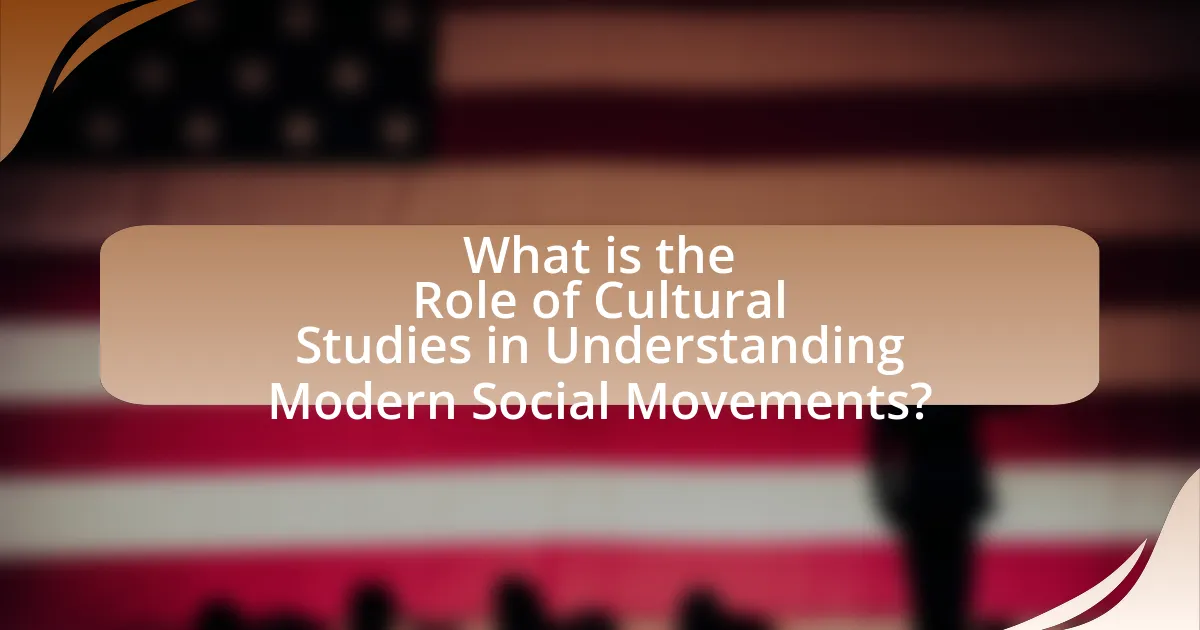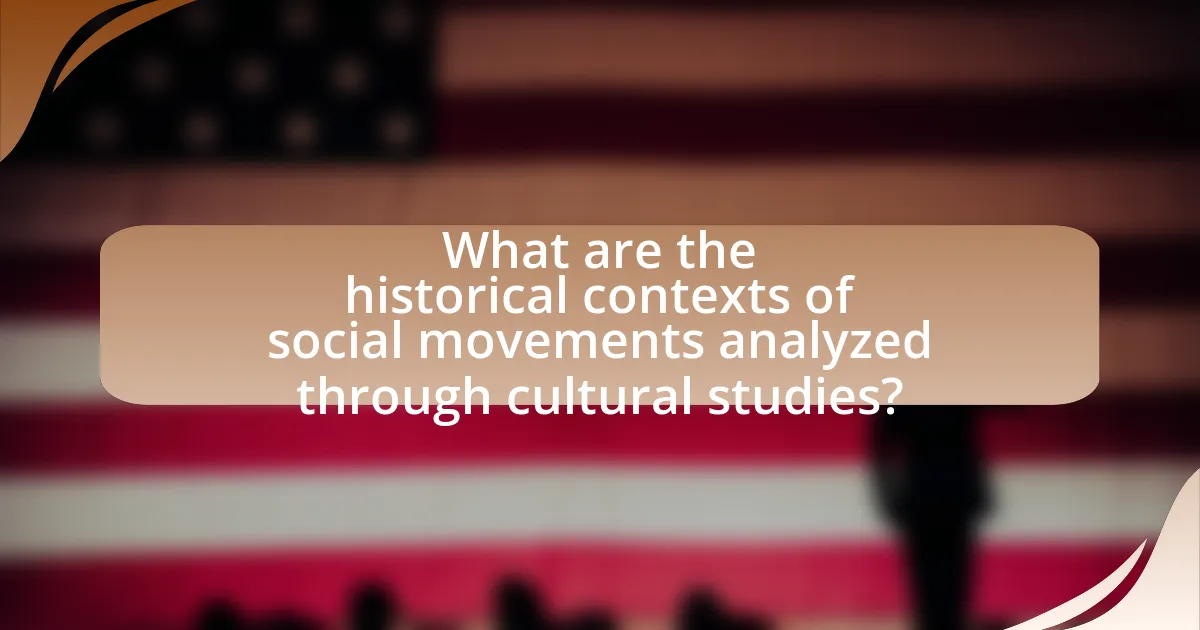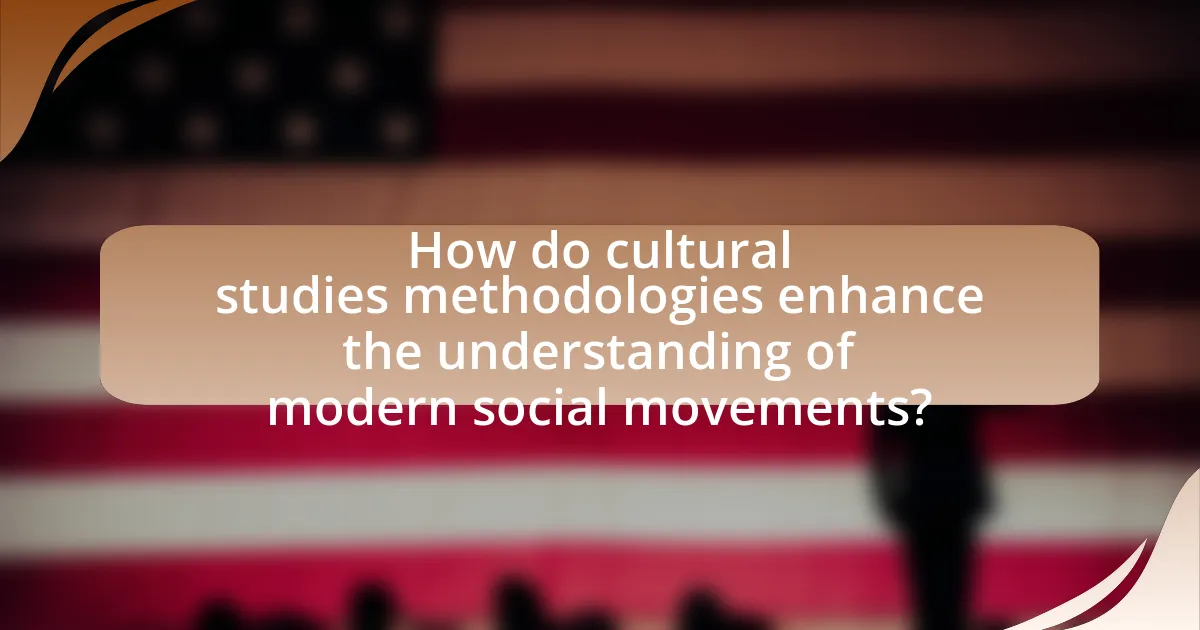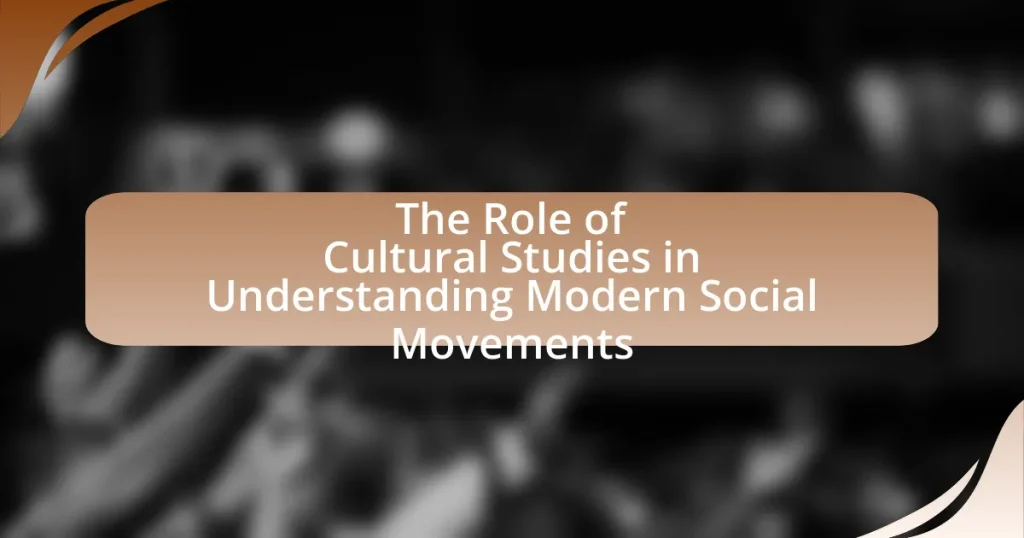Cultural studies play a vital role in understanding modern social movements by analyzing the cultural contexts, symbols, and narratives that shape collective identities and actions. This interdisciplinary field examines how culture influences social dynamics, particularly in movements such as Black Lives Matter and LGBTQ+ rights, highlighting the impact of media representation and cultural discourse on public perception and mobilization strategies. Key concepts such as identity, representation, hegemony, and discourse are explored to provide insights into the motivations behind social movements and the ways they articulate their goals. Additionally, the article discusses the historical contexts of social movements, the role of media in shaping cultural perceptions, and the methodologies used in cultural studies to enhance the understanding of these movements.

What is the Role of Cultural Studies in Understanding Modern Social Movements?
Cultural studies play a crucial role in understanding modern social movements by analyzing the cultural contexts, symbols, and narratives that shape collective identities and actions. This interdisciplinary field examines how culture influences social dynamics, enabling researchers to explore the motivations behind movements, such as the Black Lives Matter and LGBTQ+ rights movements. For instance, cultural studies highlight how media representation and cultural discourse impact public perception and mobilization strategies, as seen in the use of social media platforms to amplify voices and foster community engagement. By focusing on the interplay between culture and politics, cultural studies provide insights into the ways social movements articulate their goals and challenge dominant ideologies, thereby enriching our comprehension of contemporary societal changes.
How do cultural studies contribute to the analysis of social movements?
Cultural studies contribute to the analysis of social movements by examining the cultural contexts, symbols, and narratives that shape collective identities and mobilization strategies. This interdisciplinary approach allows researchers to understand how cultural practices and representations influence the formation and dynamics of social movements. For instance, cultural studies highlight the role of media in framing social issues, as seen in the Black Lives Matter movement, where social media platforms amplified voices and narratives that challenged systemic racism. By analyzing these cultural dimensions, scholars can uncover the ways in which social movements negotiate meaning, build solidarity, and enact change within society.
What key concepts in cultural studies are relevant to social movements?
Key concepts in cultural studies relevant to social movements include identity, representation, hegemony, and discourse. Identity shapes how individuals and groups perceive themselves and their roles within social movements, influencing participation and solidarity. Representation examines how social movements are portrayed in media and culture, affecting public perception and support. Hegemony, as defined by Antonio Gramsci, refers to the dominance of certain ideologies over others, which can either empower or marginalize social movements. Discourse analysis, rooted in the work of Michel Foucault, explores how language and communication shape social realities and mobilize collective action. These concepts provide a framework for understanding the dynamics and impact of social movements within cultural contexts.
How do cultural narratives shape social movements?
Cultural narratives shape social movements by providing a framework through which individuals interpret their experiences and mobilize for change. These narratives create shared identities and collective goals, enabling participants to connect their personal struggles to broader societal issues. For instance, the civil rights movement in the United States utilized narratives of equality and justice, which resonated deeply with the African American community and garnered support from diverse groups. This alignment of personal and collective narratives facilitated organized action, as seen in events like the March on Washington in 1963, where Martin Luther King Jr.’s “I Have a Dream” speech articulated a vision that unified and inspired millions. Thus, cultural narratives are essential in shaping the motivations, strategies, and cohesion of social movements.
Why is it important to study social movements through a cultural lens?
Studying social movements through a cultural lens is important because it reveals how cultural narratives, symbols, and practices shape collective identities and mobilization strategies. Cultural elements influence the way movements communicate their goals, resonate with participants, and attract broader public support. For instance, the Civil Rights Movement in the United States utilized cultural symbols like music and art to convey messages of justice and equality, which helped galvanize support and foster a sense of community among diverse groups. This cultural framing not only enhances understanding of the movement’s dynamics but also illustrates how cultural contexts can affect the success or failure of social movements.
What insights can cultural studies provide about the motivations behind social movements?
Cultural studies provide insights into the motivations behind social movements by analyzing the cultural contexts, identities, and power dynamics that shape collective actions. This field examines how cultural narratives, symbols, and practices influence individuals’ perceptions and motivations, thereby driving social change. For instance, the civil rights movement in the United States was fueled by cultural expressions such as music, literature, and art, which articulated the struggles and aspirations of marginalized communities. Additionally, cultural studies highlight the role of media in framing social issues, as seen in the global climate movement, where visual storytelling has mobilized public support and awareness. These analyses demonstrate that understanding the cultural dimensions of social movements is essential for comprehending their motivations and impacts.
How do cultural identities influence participation in social movements?
Cultural identities significantly influence participation in social movements by shaping individuals’ motivations, perspectives, and collective actions. For instance, marginalized groups often mobilize around shared cultural identities to address specific grievances, as seen in movements like Black Lives Matter, which emphasizes racial identity and systemic injustice. Research indicates that cultural narratives and symbols play a crucial role in fostering solidarity and engagement within these movements, as they resonate deeply with participants’ lived experiences. A study by Della Porta and Diani (2006) highlights how cultural frames can enhance group cohesion and motivate individuals to join collective efforts for social change.

What are the historical contexts of social movements analyzed through cultural studies?
The historical contexts of social movements analyzed through cultural studies include the examination of socio-political environments, cultural narratives, and collective identities that shape activism. Cultural studies scholars investigate how movements such as the Civil Rights Movement in the 1960s, feminist movements, and LGBTQ+ rights campaigns are influenced by historical events, media representations, and cultural discourses. For instance, the Civil Rights Movement was deeply rooted in the historical context of racial segregation and discrimination in the United States, which was reflected in cultural expressions like music, literature, and visual arts that mobilized public sentiment and solidarity. Additionally, cultural studies highlight the role of globalization and technology in shaping contemporary movements, as seen in the Arab Spring, where social media facilitated the organization and dissemination of ideas. These analyses underscore the importance of understanding the interplay between culture and history in the evolution and impact of social movements.
How have past social movements informed current cultural studies approaches?
Past social movements have significantly shaped current cultural studies approaches by providing frameworks for analyzing power dynamics, identity, and resistance. For instance, the civil rights movement of the 1960s introduced critical race theory, which examines how race and racism intersect with other social categories, influencing contemporary cultural studies to focus on intersectionality. Additionally, feminist movements have prompted cultural studies to explore gender representation and the role of patriarchy in media and culture, leading to a deeper understanding of gendered experiences. The LGBTQ+ rights movement has similarly informed cultural studies by emphasizing the importance of queer theory, which critiques heteronormativity and explores diverse sexual identities. These historical movements have laid the groundwork for contemporary cultural studies to address social justice issues, making them essential for understanding modern social dynamics.
What examples illustrate the evolution of social movements in cultural contexts?
The evolution of social movements in cultural contexts can be illustrated by the Civil Rights Movement in the United States and the LGBTQ+ rights movement. The Civil Rights Movement, which gained momentum in the 1950s and 1960s, sought to end racial segregation and discrimination against African Americans, leading to significant legislative changes such as the Civil Rights Act of 1964. This movement was deeply rooted in cultural expressions, including music, literature, and art, which galvanized public support and awareness.
Similarly, the LGBTQ+ rights movement has evolved significantly since the Stonewall Riots in 1969, transitioning from a marginalized struggle for acceptance to a broader fight for equality and legal recognition, exemplified by the legalization of same-sex marriage in many countries. Cultural representations in media, literature, and public discourse have played a crucial role in shaping perceptions and advancing the movement’s goals. Both movements demonstrate how cultural contexts influence social activism and the strategies employed to achieve social change.
How do historical narratives impact contemporary social movements?
Historical narratives significantly shape contemporary social movements by providing context, legitimacy, and a framework for collective identity. These narratives often draw on past struggles, such as the Civil Rights Movement in the United States, which serves as a reference point for current movements advocating for racial justice. For instance, the Black Lives Matter movement utilizes historical accounts of systemic racism and police brutality to highlight ongoing injustices, thereby reinforcing its mission and mobilizing support. Additionally, historical narratives can inspire activism by showcasing successful strategies and outcomes from previous movements, as seen in the LGBTQ+ rights movement, which references the Stonewall Riots to galvanize contemporary efforts for equality. Thus, the interplay between historical narratives and social movements is crucial for understanding their development and impact.
What role does media play in shaping cultural perceptions of social movements?
Media plays a crucial role in shaping cultural perceptions of social movements by influencing public discourse and framing narratives. Through various platforms, such as television, social media, and print, media outlets disseminate information that can either amplify or diminish the visibility of social movements. For instance, the coverage of the Black Lives Matter movement has significantly impacted societal attitudes towards racial justice, with studies indicating that increased media attention correlates with heightened public awareness and support for the movement’s goals. Additionally, the portrayal of activists and their messages can shape how audiences perceive the legitimacy and urgency of the movement, as seen in the contrasting representations of environmental protests in mainstream media versus alternative outlets. Thus, media not only informs but also actively constructs the cultural context in which social movements operate.
How do different media platforms influence public understanding of social movements?
Different media platforms significantly influence public understanding of social movements by shaping narratives, disseminating information, and facilitating engagement. Social media platforms like Twitter and Facebook allow for real-time sharing of events and mobilization, which can amplify voices and perspectives that traditional media may overlook. For example, the Black Lives Matter movement gained momentum through hashtags and viral posts, which helped to raise awareness and foster community support. Traditional media, such as television and newspapers, often frame social movements through specific lenses, impacting public perception and understanding. Research by the Pew Research Center indicates that 53% of Americans say social media has been important for raising awareness about social issues, demonstrating the critical role these platforms play in shaping discourse.
What are the implications of representation in media for social movements?
Representation in media significantly influences social movements by shaping public perception and awareness. When marginalized groups are accurately represented, it fosters empathy and understanding, which can mobilize support and drive social change. For instance, the portrayal of the Black Lives Matter movement in mainstream media has raised awareness about systemic racism, leading to increased public engagement and policy discussions. Conversely, misrepresentation can perpetuate stereotypes and hinder progress, as seen in the underrepresentation of LGBTQ+ voices in media, which can lead to societal ignorance and discrimination. Thus, the implications of representation in media are profound, affecting both the visibility and effectiveness of social movements.

How do cultural studies methodologies enhance the understanding of modern social movements?
Cultural studies methodologies enhance the understanding of modern social movements by providing critical frameworks that analyze the cultural contexts, symbols, and narratives that shape these movements. These methodologies emphasize the importance of cultural representation and identity, allowing researchers to explore how social movements communicate their goals and values through various media and cultural practices. For instance, the study of visual culture in movements like Black Lives Matter reveals how imagery and social media campaigns mobilize support and influence public perception. Additionally, cultural studies methodologies facilitate an intersectional analysis, recognizing how factors such as race, gender, and class intersect within social movements, thereby offering a more nuanced understanding of their dynamics and impacts. This approach is supported by scholars like Stuart Hall, who emphasized the role of culture in shaping political identities and social change.
What qualitative methods are commonly used in cultural studies to analyze social movements?
Qualitative methods commonly used in cultural studies to analyze social movements include ethnography, interviews, focus groups, and discourse analysis. Ethnography allows researchers to immerse themselves in the social movement’s environment, providing rich, contextual insights into participants’ experiences and motivations. Interviews facilitate in-depth conversations with activists, uncovering personal narratives and perspectives that shape the movement. Focus groups enable discussions among participants, revealing collective attitudes and strategies. Discourse analysis examines the language and communication used within and about social movements, highlighting how narratives are constructed and contested. These methods collectively contribute to a nuanced understanding of the dynamics and implications of social movements within cultural contexts.
How do ethnographic studies contribute to understanding participant experiences in social movements?
Ethnographic studies significantly enhance the understanding of participant experiences in social movements by providing in-depth, qualitative insights into the lived realities of individuals involved. These studies immerse researchers in the social contexts of movements, allowing them to observe behaviors, interactions, and cultural practices firsthand. For instance, ethnographic research conducted during the Black Lives Matter movement revealed how participants navigate their identities and collective actions within a broader socio-political landscape, highlighting the emotional and psychological dimensions of activism. This method captures the nuances of participant motivations, beliefs, and the impact of social dynamics, which quantitative methods may overlook. By documenting personal narratives and community interactions, ethnographic studies contribute to a richer, more comprehensive understanding of how social movements shape and are shaped by participant experiences.
What role does discourse analysis play in interpreting social movement narratives?
Discourse analysis plays a crucial role in interpreting social movement narratives by examining the language, symbols, and communication strategies used by movements to construct their identities and goals. This analytical approach reveals how narratives are shaped by cultural, political, and social contexts, allowing researchers to understand the underlying power dynamics and ideologies that influence public perception and mobilization efforts. For instance, studies have shown that the framing of issues within social movements can significantly impact their effectiveness and public support, as seen in the civil rights movement where language around equality and justice was pivotal in garnering widespread attention and action.
What challenges do cultural studies face in analyzing modern social movements?
Cultural studies face significant challenges in analyzing modern social movements, primarily due to the complexity and fluidity of these movements. The dynamic nature of social movements, which often involve diverse and rapidly changing identities, makes it difficult for cultural studies to establish clear frameworks for analysis. Additionally, the intersectionality of issues such as race, gender, and class complicates the understanding of how these movements operate and resonate within different cultural contexts.
Moreover, the reliance on traditional methodologies may limit the ability of cultural studies to capture the nuances of digital activism, which has become a prominent feature of modern social movements. For instance, the rise of social media platforms has transformed how movements organize and communicate, necessitating new analytical approaches that traditional cultural studies may not adequately address.
These challenges highlight the need for cultural studies to adapt and evolve in order to effectively analyze and interpret the complexities of contemporary social movements.
How do intersectionality and diversity complicate cultural studies approaches?
Intersectionality and diversity complicate cultural studies approaches by introducing multiple, overlapping social identities that challenge singular narratives. Cultural studies traditionally focused on specific cultural phenomena, but intersectionality reveals how race, gender, class, and sexuality intersect, creating unique experiences that cannot be understood in isolation. For instance, Kimberlé Crenshaw’s work on intersectionality highlights how Black women face discrimination that is distinct from that experienced by white women or Black men, necessitating a more nuanced analysis. This complexity requires cultural studies scholars to adopt interdisciplinary methods and consider a broader range of perspectives, which can complicate research design and theoretical frameworks.
What are the limitations of cultural studies in addressing global social movements?
Cultural studies face significant limitations in addressing global social movements due to their often localized focus and theoretical frameworks that may not adequately account for the complexities of transnational issues. This localized focus can lead to an oversimplification of global dynamics, as cultural studies frequently prioritize specific cultural contexts over broader socio-political factors. For instance, cultural studies may emphasize identity politics and representation, which can obscure the economic and structural inequalities that drive social movements on a global scale. Additionally, the reliance on qualitative methodologies in cultural studies can limit the ability to generalize findings across diverse contexts, making it challenging to draw connections between different movements. This limitation is evident in the analysis of movements like the Arab Spring, where cultural interpretations often failed to incorporate the economic and political grievances that fueled widespread protests.
What practical insights can be gained from cultural studies for activists and scholars?
Cultural studies provide activists and scholars with practical insights into the dynamics of power, identity, and representation within social movements. By analyzing cultural texts and practices, activists can better understand how narratives shape public perception and mobilization efforts. For instance, the study of media representations reveals how marginalized groups are often portrayed, which can inform strategies to counteract stereotypes and promote more inclusive narratives. Additionally, cultural studies emphasize the importance of intersectionality, highlighting how various social identities (such as race, gender, and class) intersect to influence individuals’ experiences and activism. This understanding can lead to more effective coalition-building among diverse groups, as seen in movements like Black Lives Matter, which integrates various social justice issues. Thus, cultural studies equip activists and scholars with critical tools to analyze and navigate the complexities of modern social movements.
How can cultural studies inform strategies for effective social movement engagement?
Cultural studies can inform strategies for effective social movement engagement by analyzing the cultural contexts and narratives that shape public perceptions and mobilization efforts. By understanding how cultural identities, symbols, and practices influence social movements, activists can tailor their messages to resonate more deeply with diverse audiences. For instance, research by Stuart Hall emphasizes the importance of representation and meaning-making in cultural discourse, which can guide movements in crafting inclusive narratives that reflect the experiences of marginalized groups. Additionally, cultural studies highlight the role of media in shaping social movements; for example, the use of social media platforms has been shown to amplify grassroots movements, as evidenced by the Arab Spring, where cultural expressions played a crucial role in mobilization. Thus, integrating insights from cultural studies enables social movements to develop more effective engagement strategies that are culturally relevant and impactful.
What best practices can be derived from cultural studies for analyzing social movements?
Best practices derived from cultural studies for analyzing social movements include employing interdisciplinary approaches, focusing on the narratives and symbols used by movements, and understanding the socio-political context. Interdisciplinary approaches integrate insights from sociology, anthropology, and media studies, enhancing the analysis of social movements. Focusing on narratives and symbols allows researchers to comprehend how movements construct identities and mobilize support, as seen in the civil rights movement’s use of powerful imagery and rhetoric. Understanding the socio-political context is crucial, as it situates movements within broader historical and cultural frameworks, exemplified by the feminist movements adapting to different cultural contexts across decades. These practices enable a comprehensive understanding of the dynamics and impacts of social movements.










